A locus is the location of a gene on it's chromosome. A gene is the carrier of an heriditary property.
A chromosome is the vehicle/carrier of the genes. Most organisms have multiple chromosomes.
Each cell has 2 copies of each type of chromosome, 1 copy from each parent, the so called chromosome pair;
exceptions are the sex chromosomes (with mammals X and Y, with birds Z and w).
A gene is mostly located on the same chromosometype, eg chromosome(pair) number 3 or 5.
So each cell also has 2 copies of a gene in general.These can be 2 equal forms or 2 different ones.
These forms of a gene, eg the wildtype or it's mutant forms are called alleles.
The genotype of an organism is the list of those alleles no matter what the outcome/appearance.
The phenotype is the appearance of the organism by the sum of the effects of all genes and alleles. Color is a part of the phenotype.
With the locus-lists you can adjust the parents' genotypes. The notation is "Allele 1 / allele 2".
The slash "/" represents the chromosomepair where the gene is located. It is short for "//".
The slash is often omitted. Instead of "Allele 1" the Gene symbol is often used.
Eg the gene with symbol A has a dominant wildtype allele A and a mutation a. Dominant alleles are often spelled with capital initials.
Wildtype alleles in some animal groups are suffixed by a plus superscript: A+. Sometimes only written as: +. I don't do that for clarity.
Dominant means that an allele is normally expressed in the appearance (apparent).
Recessive means that an allele is mostly not expressed unless it is accompanied by it's twin, in this case a/a.
There are a lot of exceptions, eg epistasis: some genes overrule the effect of other genes.
Consider having a gene B with recessive allele b causing brown color when b/b.
Now there is also a gene C with recessive allele c suppressing color when c/c.
An animal having c/c will not show brown (b/b), although it genetically is brown. That is epistatics.
Many colors are epistatic, in those cases the calculator uses the most common genotype.
When an animal is A/A or a/a at the A-locus than it's purebred or homozygous for that factor. If A/a it's heterozygous.
The animal probably shows A but carries a.
Sometimes alleles are incomplete dominant eg. blue on chickens. It always shows, but stronger when purebred.
Bl/bl+ is blue, Bl/Bl is splash, bl+/bl+ is wildtype, black on a unicolor chicken.
Then there is co-dominance. Both alleles of a genepair express, like in our bloodtype AB.
A number of color or pattern genes covered by the calculators can be located on the same chromosome (chromosomepair or -type). Thereby they could segregate together, because they are physically linked. This effect can be mimiced by the (chicken) calculator, but there is a catch. When genes are far apart on the chromosome they can segregate independantly. This is due to crossing over. Normal cells have 2 copies of all genes and chromosomes (except sexlinked). Egg- and spermcells only have 1 copy. The germline cells divide the partners of the chromosomepairs between their daughtercells. Before this separation the chromosomepair partners lay side by side, with possibility of entangling. A piece of chromosome can be interchanged then. The chance for that is very big when 2 genes are far enough apart on the chromosome. When the genes' loci (locus plural) are close to one another on the chromosome there is a certain chance of recombination. This chance is NOT computed into the crossing result from the calculator. Except in the new beta version of the Chicken Crossing-Over Calculator.
Male chickens (and birds in general) have 2 sex chromosomes, called "Z", per cell, thus a two fold genetic package;
Hens only have one Z chromosome per cell. They also have a smaller counterpart, the thiny chromosome "w"
with no applicable information on it.
The germcells, spermcells with the rooster and eggcells with the hen, comprise half the (recall: two fold) genetic load that normal cells contain.
When joined the genetic load is complete again.
The genetic material, the DNA, is grouped into chromosomes, the carriers of the genes, that carry the heriditairy properties.
Each type of chromosome has 2 representatives (the "chromosome pair"), one from each parent.
Exception is the sex chromosome pair, that can be an odd couple, eg in the hen: Z//w.
The non sexlinked chromosomes are called autosomes and always are an "even" shaped couple.
Most organisms, including chickens, have many autosome pairs per cell but only 1 pair of sex chromosomes.
The rooster gives half of his genetic information to a spermcell, the hen also but because she lacks a second Z chromosome,
she partly donates an incomplete set which is written as "-".
So the rooster always donates a Z and the female donates a Z or the odd partner w ("-").
That means that all offspring of the rooster always receives a Z from him.
Since hens only have one Z it always comes from their father. From their mother they get the dwarf chromosome w.
So all sexlinked traits like silver, cuckoo/barred and chocolate from the hen is from dad.
A hen can never give sexlinked traits to her daughters!
The other way around, hens will always express sexlinked traits because they lack a second possibly suppressive Z chromosome.
Summarized: In sexlinked inheritance the gender that has an odd couple of sex chromosomes alwaysexcept shows the sexlinked traits
and those traits come from the opposite gendered parent.
With normal inheritance both genders are equally mocked up by distribution and expression of genetic traits.
No statistical differences can be seen between the genders of the offspring.
Chickens have 2 kinds of pigment that define their plumage color.
These are the black (sometimes darkbrown/chocolate) pigment eumelanine, melanin for short, and the yellow/red pigment pheomelanine.
The groundcolor of a chicken is pheomelanine. When this is absent it is called "silver" which looks white.
The common silver-gene allows the expression of some red features like salmon breast or red shoulders.
In wildtype chickens the groundcolor is yellow to brown, it is called "gold".
By so called red enhancers this gold can be boosted to a (dark) red color.
For example the mahogany colored Rhode Island Red.
The gold can be diluted to a yellow, cream or lemon color. The groundcolor can thus be silver, gold, red or yellow.
Chickens are rarely fully groundcolored. An example being Buff.
This color is partly a mystery for the genes that eliminate the last bits of black are unknown.
In the chicken calculator you can approach this color by setting it to a columbian like pattern.
We will get to that later...
Next to a groundcolor a chicken often has some form of black pattern. This patterncolor could be diluted and/or of the "brown shifted" kind.
This pattern is more or less hereditary. Feathers and parts of feathers are designated to be groundcolored or pattern colored.
The wildtype chicken male and females have sexual dimorphic plumage color.
The hen has to be camouflaged and therefor is more groundcolored than the male; she has delicate black patterning. Her neck is gold with black striping towards the shoulder,
the breast is salmon colored, a kind of pheomelanin expression; the upperside is densely "stippled" on a yellow/brown background.
The rooster has more bright groundcolor shades and has big black areas with green sheen on tail and wingbands.
The breast is generally black; neck hackles, shoulder and saddle are red to gold.
The wing triangle is golden brown in wildtype male.
So how do the other patterns come about?
Chickens range from fully groundcolored to full black (pattern colored).
The latter is not that easy to make genetically, compared to other species.
Factors that make a chicken more black we call "melanizers" or black enhancers. These can work twofold.
Next to being able to increase the amount of melanin they can claim a piece of groundcolor-area.
Note that black pigment is not just put on top of the groundcolor!
Dominant white for instance inhibits melanin but groundcolor is not allowed to get a foothold on the area where the melanin should have been.
White being the absence of pigment.
In most animal species a single mutation can make a self black. Not so for chickens, and especially not in roosters.
The base for a black chicken is a favorable allele of the "Black Extension"-gene symbol E.
The most melanizing and most dominant form, the so called "Extended black" symbol E, while making the females largely black,
it turns the males into mere melanized wildtype looking ones, but with a black wing triangle (crow wing).
Other melanizers have to close the deal. A number of those are well documented, but many are not.
Next in line, on melanizing effect and dominance, are the "Birchen" alleles, simplified as one allele symbol ER.
Birchen animals look like extended black ones but are more beautiful: the groundcolor parts are more clean.
The hen has a groundcolor neck also, else she is black. Both sexes can have groundcolor lacing on the upper breast.
By selection this lacing can cover the whole body, or could be absent completely.
By extra melanizers birchen animals can become full black.
Next on melanizing power is "Partridge/Brown" symbol eb, the most recessive form hence lower case e.
The males are wildtype looking including groundcolor wing triangle, but they have heavier hackle and saddle striping.
Their underfluff is often dark. The hens are wildtype except they lack the salmon breast; it is stippled instead.
Sometimes black animals are based on this partridge/brown color. They have light underfluff and can have nice yellow legs (by another gene).
This requires multiple, partly unknown, additional melanizers.
This color is also difficult to set in the chicken calculator. Set both "Melanotic" and "Charcoal" to "melanized".
Typical for this kind of black is that "Columbian"-like restrictors can turn the black breast (and wingbows) to groundcolor,
while the more dominant E-alleles described above do not allow this; "duckwing" and wheaten do however.
Examples are quail color and lakenvelder pattern.
Then there is the wildtype e+, let's call it "Duckwing" for now.
Given enough melanizers this one turns black also, but, like wheaten, not that easily.
Because the hen lacks black pattern on breast, this allele is less suitable for patterns with black pattern on breast.
Both partridge/brown and duckwing are called "partridge", causing confusion in discussions.
Finally "Wheaten" symbol EWh, upper case because it was assumed dominant to the "partridges",
but since that fact is doubtful (a further allele "recessive" wheaten has become obsolete) it is sometimes written lowercase.
Wheaten is the most suitable allele for red expression and the least suitable for black expression.
The hens are mostly wheaten colored with little to no black markings on neck and back.
The black tail is also prone to lose color. The salmon breast color is relocated to shoulder and back.
Roosters look wildtype but have less hackle and saddle striping, and mostly light underfluff.
Melanizers however could mask those traits.
Next to the black boosting system there is a counteracting mechanism.
Best known is the so called Columbian factor symbol Co.
Columbian chickens are more groundcolored looking.
For roosters the most obvious effect is that breast and wingbands are not black but groundcolor. The groundcolor is also more even.
The hen loses the salmon breast coloring by this effect and becomes more warm in groundcolor.
Her black pattern is restricted to her back and saddle, if not further towards the tail.
These colors are better camouflage for sandy terrains. Chickens are originally jungle fowl.
The dimorphism between rooster and hen is much less, and a lot of uniform patterns on groundcolor are columbian based.
Columbian is not just a black restrictor, it also shifts black pigment. Hens with columbian get a tail that is more black and with more green sheen.
Columbian inhibits red expression on silver groundcolor. It has more effect on males than females, especially their backs and saddles.
Next to columbian there is another restrictor called "Darkbrown" Db, a confusing name for it is the effect on black chickdown that it refers to.
This gene is more effective on males also and has even less effect on restricting backpattern of females. Red inhibition is also less.
The gene does have restricting effects for chickens based on "extended black" or "birchen"; columbian alone does not.
A few other genes are said to have a mild columbian like restriction effect like red enhancer Mahogany Mh.
Columbian and Darkbrown influence a lot of complex patterns also.
Meant are black patterns on individual groundcolored feathers, not the dark/melanized versions of wildtype up to black.
Examples are lacing (concentric pencilling, double and single lacing), spangling (not mottling) and transverse pencilling (autosomal barring).
Sexlinked barring or cuckoo is in the next paragraph ... .
Black pigment is shifted and sometimes enhanced for these effects.
An important melanizer to do just that, and thereby influencing patterns, is "Melanotic" Ml.
Melanotic is dominant, especially for the females, and is able to make "extended black" and "birchen" based animals full black.
It enhances and shifts black pigment to the edges of the feather. A typical effect is halfmoon spangling on the tips of the feather.
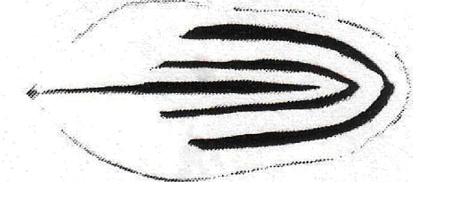 Pattern gene Pg arranges black pigment, eg the stippling, in concentric lines. Pg alone leaves the feather rim (outerlace) groundcolored.
The black breast of the rooster can become groundcolor tipped by this effect. This is concentric pencilling or multiple lacing (Pg).
Pattern gene Pg arranges black pigment, eg the stippling, in concentric lines. Pg alone leaves the feather rim (outerlace) groundcolored.
The black breast of the rooster can become groundcolor tipped by this effect. This is concentric pencilling or multiple lacing (Pg).
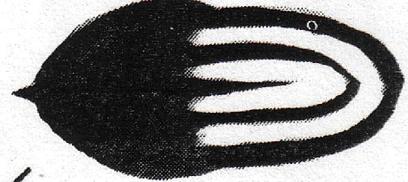 Combined with Ml the concentric lines become broader and shift towards the edge of the feather, making the outer rim black: double laced (Pg+Ml).
Roosters become quite dark by the action of Ml.
Combined with Ml the concentric lines become broader and shift towards the edge of the feather, making the outer rim black: double laced (Pg+Ml).
Roosters become quite dark by the action of Ml.
 By adding Columbian Co the inner laces are removed and you get single lacing (Pg+Ml+Co).
By adding Columbian Co the inner laces are removed and you get single lacing (Pg+Ml+Co).
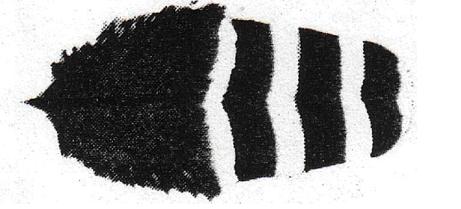
 When you add Darkbrown Db to concentric pencilling then the pencilling becomes transverse: autosomal barring (Db+Pg).
Given enough black this will be true barring like in the Campine breed, else the bars are "pinched" at the edges and nerve giving a wheatear type pattern, quill.
When you add Darkbrown Db to concentric pencilling then the pencilling becomes transverse: autosomal barring (Db+Pg).
Given enough black this will be true barring like in the Campine breed, else the bars are "pinched" at the edges and nerve giving a wheatear type pattern, quill.
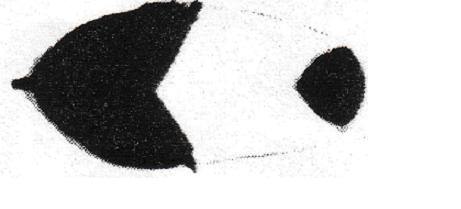 Adding Melanotic Ml will render complete spangling at the tip of the feather as in the Hamburgh breed: spangled (Db+Pg+Ml).
Adding Melanotic Ml will render complete spangling at the tip of the feather as in the Hamburgh breed: spangled (Db+Pg+Ml).
Finally adding columbian will give single lacing again, but not with a solid tail but a laced one as in the Sebright breed (Db+Pg+Ml+Co).
Most patterns are on "partridge/brown" or "birchen" base.
The latter needs Darkbrown Db to show pattern.
Absence of all pigment delivers a white color.
Dominant white (Inhibitor I) inhibits mainly black pigment, rendering the pattern white.
Recessive white (Colorless c) inhibits both pigmentkinds, but could leak red.
Mottled (mo) is a temporary/local inhibition of both pigments, especially at the feathertip. Sometimes larger areas get white.
This inhibition, maybe by building up melanin, is followed often by extreme melanin deposits leading to a black band surrounding the white tip.
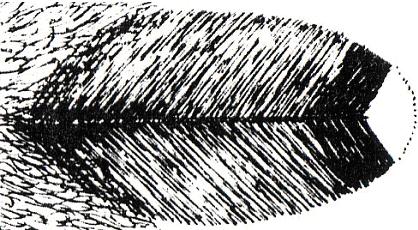 The sexlinked Barring factor (B) inhibits pigmentdepositing from time to time, giving a barred pattern.
The sexlinked Barring factor (B) inhibits pigmentdepositing from time to time, giving a barred pattern.
 Factors affecting feathergrowth also affect the sharpness of the barring. In general the barring is rather unsharp, being blue-light grey instead of black and white.
Factors affecting feathergrowth also affect the sharpness of the barring. In general the barring is rather unsharp, being blue-light grey instead of black and white.
Best studied eumelanin diluter is Dominant White. Heterozygotes often show a grayish tint of white and speckles of colored feathers.
This white is epistatic to all other eumelanin diluters. Phaeomelanin is not greatly affected, at least in 1 dose.
In my own experience Dominant White seems to act as a melanizer, expanding the former black patterned areas.
This could be interpreted as phaeomelanin inhibition also, the old consensus.
Most common after that is Blue, being the heterozygous form of Splash.
This a gray dilution of black that has a nice contrast with the gold and red tints of the chicken's groundcolor, which it does not affect.
Blue tends to be uneven, dark edged or speckled with black and can be darkened by melanizers up to flat black. It also tends to get rusty.
Splash (homozygous) is similar to heterozygote Dominant White as it can range from pure white to grayish and speckled.
Then came Lavender or self blue, for the other blue tends to be laced in appearance.
This is a recessive mutation often associated with bad feather structure. Ihe consensus is that it is epistatic to the other dilutants by the nature of expression mechanism.
Truely epistatic would mean however that it would also cover splash or khaki (hence "white?" in table below). This needs to be confirmed either way.
Until then the fanciers' consensus is that the whites would not permit to show the lavender tint. This tint is lighter than splash Blue.
Other poultry species' lavenders/self blues do not seem to act epistatic to other diluters and contribute in further dilution of the eumelanin.
Lavender also dilutes Phaeomelanin (groundcolor) in chickens.
Breeding tip: how to breed with lavender...
Dominant White mutation has produced a revertant mutation called Smoky. This allele is dominant to Dominant White but recessive to wildtype.
It acts against the mechanism of Dominant White rendering a smoky blue color similar to splash Blue. This blue color would be purebreedable like lavender.
The mutation is very rare though, so don't worry about your splash Blue chickens.
There is another allele on the Dominant White gene/locus called Dun. It is recessive to Dominant White but (semi-)dominant to the other alleles.
Two copies of the allele render a Khaki color, also called Dun Splash for it can be very white. It is also a clean kind of white, no specks.
Darkened by melanizers it gives a nice light brownish lavender tint. One copy of the allele gives a chocolate color instead of black.
This is a nice even color ranging from brownish gray to near black chocolate color (probably due to melanizers). No black spots like splash Blue can have.
Dun is not very common in some continents, as is Chocolate. Both mutations are often missed or seen as off black.
Chocolate is a sex linked recessive mutation with a similar appearance as heterozygous Dun. The chick down seems darker though.
In a recent visit to the dutch Serama empire there was a pullet harbouring both Dun and Chocolate. She was a lighter but prominent brown.
Sexlinked brown dilution is the most common eumelanin dilution among birds and poultry, but still very rare in chickens.
Breeding tip: how to breed with chocolate...
Phaeomelanin diluters do not dilute eumelanin, although in some buff chicken breeds the tail-black seems affected. These diluters are not identified.
The table below shows the expected effect of combined eumelanin diluters (The calculator can deviate for unknown combinations):
| Blue | Splash (=Blue DF) | Dun | Khaki (=Dun DF) | Lavender | Dom.White | Chocolate | |
| Blue | Blue | Khaki (Platinum) | White | Lavender | White | Khaki (Mauve) | |
| Splash (=Blue DF) | White | White | White | White? | White | White | |
| Dun | Khaki (Platinum) | White | Chocolate | Lavender | White | Light Brown (Beige?) | |
| Khaki (=Dun DF) | White | White | Khaki | White? | not possible | White | |
| Smoky | Light Blue? | White | Chocolate? Khaki? | not possible | Lavender | Smoky | Khaki? |
| Lavender | Lavender | White? | Lavender | White? | Lavender | White | Lavender |
| Dom.White | White | White | White | not possible | White | White | White |
| Chocolate | Khaki (Mauve) | White | Light Brown (Beige?) | White | Lavender | White | Chocolate |
| Blue+Dun= Khaki (Platinum) | Lavender | White | White? | ||||
| Blue+Chocolate= Khaki (Mauve) | White? | White | Lavender | White | |||
| Dun+Chocolate= Light Brown (Beige?) | White? | White | Lavender | White |